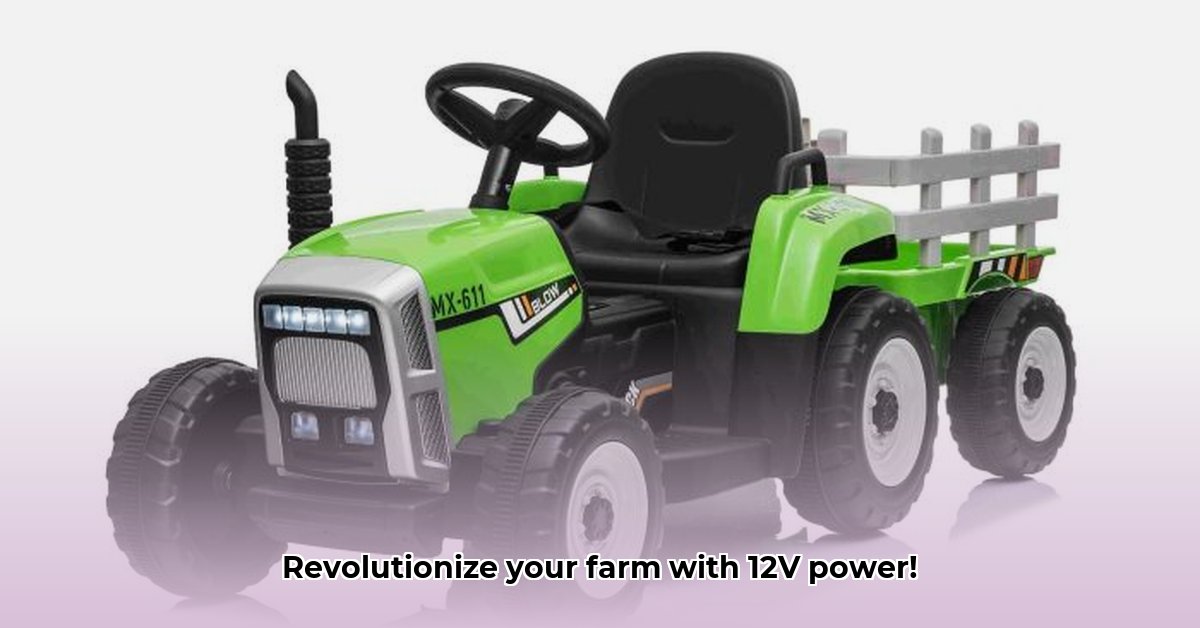
12V Battery Tractor: Powering Up Your Farm's Future
Farming demands resilience. Long hours, unpredictable weather, and the constant strain on equipment necessitate reliable power sources. Your 12V battery tractor, the heart of many operations, requires a battery that's both robust and sustainable. Currently, lead-acid batteries dominate the agricultural landscape. Their durability and affordability are undeniable advantages, but their environmental footprint raises significant concerns. This guide explores the current state of 12V tractor batteries, examines emerging technologies, and outlines actionable steps for a more sustainable future in agriculture. For more information on farm tractor costs, check out this helpful resource: tractor costs.
The Current State of 12V Tractor Batteries: A Workhorse With Drawbacks
Lead-acid batteries are the industry standard, prized for their proven reliability and relatively low initial cost. Farmers rely on their consistent performance in demanding conditions. However, their shorter lifespan compared to newer technologies translates to increased replacement costs and significant waste generation. Moreover, lead is a toxic heavy metal, and the manufacturing and disposal processes pose considerable environmental risks. While recycling programs aim to mitigate these risks, their overall efficiency and comprehensiveness remain a concern. Aren't there better, greener options?
New and Improved: Technological Advancements in Battery Technology
Fortunately, the battery technology landscape is transforming. Computer-aided design (CAD) (computer-assisted design software for optimizing battery designs) is revolutionizing battery engineering, resulting in stronger, more efficient, and longer-lasting designs. Innovations such as calcium lead alloy in lead-acid batteries allow for "waterless" operation, reducing maintenance burdens. Dry-charge processes enhance shelf life, ensuring readiness when needed.
Beyond lead-acid, lithium-ion and solid-state batteries represent promising alternatives. They offer substantially higher energy density (meaning more power for the same size), faster charging times, and potentially longer lifespans. These advantages significantly benefit farmers relying on continuous equipment operation. However, the higher upfront cost of lithium-ion batteries, ethical sourcing concerns for raw materials, and the nascent stage of solid-state technology present challenges that need careful consideration. "The transition to these newer technologies requires careful planning and assessment of their lifecycle impacts," notes Dr. Anya Sharma, Lead Researcher at the Institute for Sustainable Agriculture.
Sustainability: The Key to a Greener Farm
The full environmental impact of batteries must be considered, encompassing raw material sourcing, manufacturing, usage, and disposal. Responsible sourcing of materials is crucial. "We need to move away from practices that have a detrimental impact on the environment and the communities affected by mining activities," emphasizes Dr. David Lee, professor of Environmental Engineering at the University of California, Berkeley. Robust recycling programs are indispensable for recovering valuable materials and preventing environmental contamination. Stronger regulations coupled with financial incentives can promote the adoption of sustainable practices.
What Can We Do? A Collaborative Approach to Sustainable Farming
Creating a sustainable agricultural future requires a collective effort:
For Battery Manufacturers:
- Conduct comprehensive lifecycle assessments (LCAs) to quantify the environmental impact.
- Invest heavily in R&D of next-generation batteries, focusing on recyclability and ethical material sourcing.
For Farmers and Agribusinesses:
- Consider the total cost of ownership (TCO), factoring in lifecycle costs rather than solely initial price.
- Explore electric or hybrid equipment to leverage superior battery technologies.
- Implement battery management systems (BMS) to optimize battery performance and prolong lifespan.
For Governments and Regulators:
- Implement financial incentives like grants and tax credits to encourage sustainable technology adoption.
- Enact and enforce regulations for sustainable battery recycling and end-of-life management.
For Research Institutions:
- Fund R&D focused on enhancing battery longevity, energy density, and environmental sustainability.
- Develop standardized testing protocols for agricultural applications.
Weighing the Options: A Comparison of Battery Technologies
The choice of battery technology requires careful evaluation of various factors:
| Technology | Short-Term Risks | Long-Term Risks | Mitigation Strategies |
|---|---|---|---|
| Lead-Acid Batteries | Environmental concerns during disposal; shorter lifespan | Continued reliance on finite resources; high disposal costs | Invest in robust recycling; explore alternatives |
| Lithium-ion Batteries | Higher initial cost; potential for thermal runaway | Supply chain vulnerabilities; ethical sourcing of materials | Diversify supply chains; improve battery safety; robust BMS |
| Solid-State Batteries | High R&D costs; immature technology | Scalability challenges; potential material limitations | Invest in R&D collaborate with materials scientists |
How to Choose Sustainable Batteries for Electric Farm Equipment
Effective battery selection hinges on understanding specific needs. Assess daily usage, operational requirements, and the overall power demands of the tractor. Prioritize energy density, lifespan, and fast-charging capabilities. Crucially, consider the entire battery lifecycle, from material sourcing to responsible disposal. Explore battery chemistries such as lead-acid, lithium-ion, and solid-state, weighing their respective advantages and disadvantages. Certifications like RoHS and CE ensure compliance with environmental regulations and safety standards. Investigate potential government incentives to offset costs and streamline the transition to sustainable battery choices.
The Future of 12V Battery Tractor Technology: A Call to Action
Sustainable agriculture necessitates responsible technology choices. Selecting appropriate batteries is not merely about operational efficiency; it's about building a greener future. By embracing sustainable practices and collaborating across stakeholders, we can collectively foster a more environmentally responsible and prosperous agricultural industry.